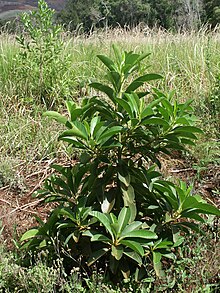Arillastrum
| Arillastrum | |
|---|---|

| |
| Scientific classification | |
| Kingdom: | Plantae |
| Clade: | Tracheophytes |
| Clade: | Angiosperms |
| Clade: | Eudicots |
| Clade: | Rosids |
| Order: | Myrtales |
| Family: | Myrtaceae |
| Subfamily: | Myrtoideae |
| Tribe: | Eucalypteae |
| Genus: | Arillastrum Pancher ex Baill.[2] |
| Species: | A. gummiferum
|
| Binomial name | |
| Arillastrum gummiferum | |
Arillastrum is a monotypic genus of trees in the myrtle family, Myrtaceae, containing the single species Arillastrum gummiferum. It is endemic to southern New Caledonia.[3][4] It is related to Eucalyptus, but more closely to Angophora and Corymbia.[5]
It is a tree up to 35 meters tall with a trunk over a meter wide. It might flower only every seven years. The flowers each have four clusters of stamens and staminodes.[4]
This species grows on ultramafic rock substrates. It grows in stands with other individuals of its species.[4]
The species has been called "one of New Caledonia's most economically and ecologically significant trees".[4] It has been heavily exploited for its strong, dark red, resinous wood, which is useful for the construction of buildings, bridges, boats, and telephone poles. Its populations have been significantly reduced by logging.[4]
References
- ^ Amice, R.; Butin, J.-P.; Fleurot, D.; Garnier, D.; Goxe, J.; Hequet, V.; Lannuzel, G.; Suprin, B.; Veillon, J.-M. (2020). "Arillastrum gummiferum". IUCN Red List of Threatened Species. 2020: e.T171131037A171161289. doi:10.2305/IUCN.UK.2020-2.RLTS.T171131037A171161289.en. Retrieved 20 November 2021.
- ^ "Arillastrum Pancher ex Baill". Plants of the World Online. The Trustees of the Royal Botanic Gardens, Kew. n.d. Retrieved July 12, 2020.
- ^ Dawson, J.W. (1992) Myrtaceae - Leptospermoideae. In Flore de La Nouvelle-Calédonie et Dépendances, edited by P. Morat and H. S. MacKee, 18: 1–251. Paris: Muséum National d’Histoire Naturelle, 1992.
- ^ a b c d e Wilcox, M. (2004). Le chêne gomme (Arillastrum gummiferum) – New Caledonia's eucalypt. Archived 2013-09-21 at the Wayback Machine Auckland Bot. Soc. J 59(1), 43-44.
- ^ Thornhill, Andrew H., Simon Y.W. Ho, Carsten Külheim, and Michael D. Crisp. (2015) "Interpreting the Modern Distribution of Myrtaceae Using a Dated Molecular Phylogeny." Molecular Phylogenetics and Evolution 93: 29–43. doi:10.1016/j.ympev.2015.07.007.
- Webarchive template wayback links
- Articles with short description
- Short description is different from Wikidata
- IUCN Red List vulnerable species
- Articles with 'species' microformats
- Myrtaceae
- Monotypic Myrtaceae genera
- Endemic flora of New Caledonia
- Taxa named by Henri Ernest Baillon
- Taxa named by Adolphe-Théodore Brongniart
- Taxa named by Jean Antoine Arthur Gris
- Taxa named by Jean Armand Isidore Pancher
- All stub articles
- Myrtaceae stubs
